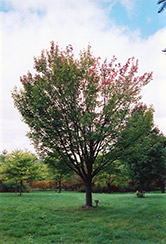Height: 30 feet
Spread: 30 feet
Sunlight:
![]()
Hardiness Zone: 4
Other Names: Swamp Maple, Scarlet Maple
Description:
A smaller cultivar of the red maple with a rigidly oval to rounded habit of growth, reliable mix of fall colors from yellow to orange to red; a good choice for smaller landscapes; intolerant of alkaline soils, susceptible to chlorosis
Ornamental Features
Tilford Red Maple features showy clusters of red flowers along the branches in early spring before the leaves. It has green deciduous foliage which emerges red in spring. The lobed leaves turn an outstanding red in the fall. It produces red samaras in late spring. The furrowed silver bark and brick red branches add an interesting dimension to the landscape.
Landscape Attributes
Tilford Red Maple is a deciduous tree with a more or less rounded form. Its average texture blends into the landscape, but can be balanced by one or two finer or coarser trees or shrubs for an effective composition.
This is a relatively low maintenance tree, and should only be pruned in summer after the leaves have fully developed, as it may 'bleed' sap if pruned in late winter or early spring. It has no significant negative characteristics.
Tilford Red Maple is recommended for the following landscape applications;
- Accent
- Shade
Planting & Growing
Tilford Red Maple will grow to be about 30 feet tall at maturity, with a spread of 30 feet. It has a low canopy with a typical clearance of 5 feet from the ground, and should not be planted underneath power lines. It grows at a fast rate, and under ideal conditions can be expected to live for 70 years or more.
This tree should only be grown in full sunlight. It is quite adaptable, prefering to grow in average to wet conditions, and will even tolerate some standing water. It is not particular as to soil type, but has a definite preference for acidic soils, and is subject to chlorosis (yellowing) of the foliage in alkaline soils. It is somewhat tolerant of urban pollution. This is a selection of a native North American species.
